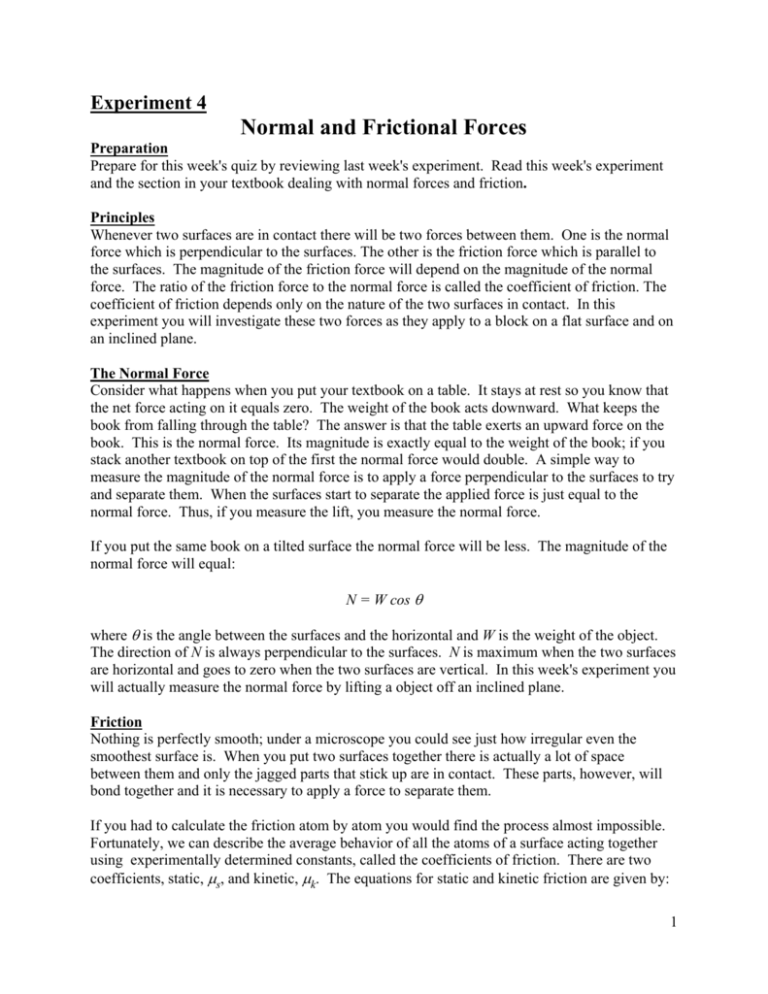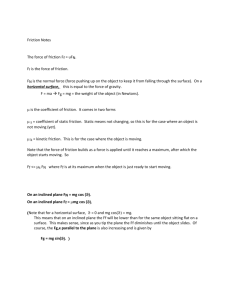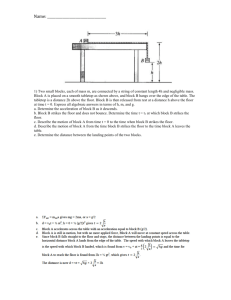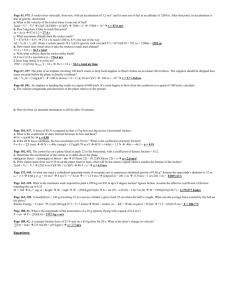Experiment 4 Normal and Frictional Forces
advertisement

Experiment 4 Normal and Frictional Forces Preparation Prepare for this week's quiz by reviewing last week's experiment. Read this week's experiment and the section in your textbook dealing with normal forces and friction. Principles Whenever two surfaces are in contact there will be two forces between them. One is the normal force which is perpendicular to the surfaces. The other is the friction force which is parallel to the surfaces. The magnitude of the friction force will depend on the magnitude of the normal force. The ratio of the friction force to the normal force is called the coefficient of friction. The coefficient of friction depends only on the nature of the two surfaces in contact. In this experiment you will investigate these two forces as they apply to a block on a flat surface and on an inclined plane. The Normal Force Consider what happens when you put your textbook on a table. It stays at rest so you know that the net force acting on it equals zero. The weight of the book acts downward. What keeps the book from falling through the table? The answer is that the table exerts an upward force on the book. This is the normal force. Its magnitude is exactly equal to the weight of the book; if you stack another textbook on top of the first the normal force would double. A simple way to measure the magnitude of the normal force is to apply a force perpendicular to the surfaces to try and separate them. When the surfaces start to separate the applied force is just equal to the normal force. Thus, if you measure the lift, you measure the normal force. If you put the same book on a tilted surface the normal force will be less. The magnitude of the normal force will equal: N = W cos θ where θ is the angle between the surfaces and the horizontal and W is the weight of the object. The direction of N is always perpendicular to the surfaces. N is maximum when the two surfaces are horizontal and goes to zero when the two surfaces are vertical. In this week's experiment you will actually measure the normal force by lifting a object off an inclined plane. Friction Nothing is perfectly smooth; under a microscope you could see just how irregular even the smoothest surface is. When you put two surfaces together there is actually a lot of space between them and only the jagged parts that stick up are in contact. These parts, however, will bond together and it is necessary to apply a force to separate them. If you had to calculate the friction atom by atom you would find the process almost impossible. Fortunately, we can describe the average behavior of all the atoms of a surface acting together using experimentally determined constants, called the coefficients of friction. There are two coefficients, static, µs, and kinetic, µk. The equations for static and kinetic friction are given by: 1 Fs ≤ µs N Fk = µkN respectively. Static friction, Fs, is the magnitude of frictional force that a body must overcome before it can begin to move. When an object is at rest this force can have any value between zero and µs N . It equals zero when no force is acting on the object and increases as increasing force is applied to the body. Its direction is always opposite that of the applied force. When the applied force is greater than µs N the object will start to move. Once the body actually begins to move, it experiences sliding friction, which acts to retard its motion. For two given surfaces sliding, or kinetic, friction, Fk, is smaller than static friction and its direction is always opposite the direction of the object's motion. Consider what happens when you put a "friction box" on a level surface and try to pull or push it. The box will not move at first because the static friction force between the bottom of the box and the plane is greater than the force you are applying. Up to a point the force will increase as you pull harder. If you attach a scale to the box and watch carefully you will see that the reading on the scale, which is the value of the force you are applying, will increase until suddenly the box breaks free and starts to slide. It will take less force to keep the box sliding once it starts to move. The force necessary to get the box moving will is: Fs max = µsN Its direction is opposite the direction the force you apply. If you then pull the box so that it moves at constant velocity the value you see on the scale will be the force necessary to overcome the kinetic friction and it will be less than the static friction force. This force will be: Fk = µkN. Now consider what happens if you put the box on a plane and start raising the plane. The magnitude of the component of the box's weight acting parallel to the plane will be: F = -W sin θ. The magnitude of the static friction force acting in the opposite direction equals: F = Fs = µsN = µsW cos θ. As long as the net force is zero the box will not move. As you increase the angle, W sin θ will increase and the normal force will decrease. The static friction force will increase until it reaches its maximum. When W sin θ is just a tiny bit larger than Fs max the box will start to slide. Once 2 it starts to move it will actually accelerate down the plane because there is now a net force acting on it. If you set the net force equal to zero at this point you can solve for µs: Fnet =0 =µsW cos θs-W sin θs You can rearrange this to see that: µs = sin θs cos θs = tan θs. You can use this same technique to find the coefficient of kinetic friction. Adjust the plane until you find the angle where the box slides down at constant velocity after you give it a push to overcome the force of static friction. This time: µk = tan θk . Now consider what happens if you pull the box up the plane at constant velocity. The sum of the forces acting on it must be zero since it is not accelerating. Three forces are now acting on the box, the force you apply, the frictional force and the component of the box's weight acting parallel to the plane. Their sum equals zero: − W sin θ − µkN + Fapplied = 0. If we take the direction up the plane to be positive, Fapplied is positive and W sin θ and µkN are negative. The net force acting on the box should be close to zero. You can test this for yourself with your equipment. Equipment 1 wood friction box 1 5 N spring balance 1 plane 1 threaded rod 1 table clamp 1 90° clamp 1 plain rod 1 protractor 2 90 cm pieces of string 250-300 grams of extra mass Procedure Be sure you remember the correct way to read a protractor. Estimate tenths of degrees. Measure forces with the scale to the nearest .1 N. 3 Friction Forces 1. Put the two hundred to three hundred grams in the friction box. You will have several masses; distribute them as evenly as possible. 2. Set the friction box on the end of the plane and push the box down so that it makes good contact with the surface of the plane. Do this for each part of the experiment. 3. Raise the end of the plane slowly until the box just starts to slide on its own. Record the angle to which you raised the plane as θs. Check a couple of times to make sure you have it right. 4. Find the angle of the plane that lets the box slide at constant velocity after you give it a slight push. Watch the box slide all the way down the plane- be sure it does not accelerate. Record this angle as θk. 5. Put another two hundred grams in the box and repeat steps 3 and 4. 6. Put four hundred more grams in the box and repeat steps two and three. 7. Put two or three hundred grams in the box. Use the balance to find the weight (W) of the box and masses together. Record this value. Normal Force 8. Use one piece of string to make a sling for the box by winding it twice around the short side, near the middle and tying a knot. Push the two loops of string apart so that the box hangs level when you suspend it from the spring balance. 10. Tie the ends of the other piece of string together to make a big loop. Hook one end of the loop over the hook on the friction box and hook the other end over the pulley at the top of the plane. Adjust the length so the box will rest about halfway up the plane. 11. Your instructor will show you how to set up the equipment so that you can raise the plane to different angles. Set the box on the plane and position it so that the string connecting it to the plane pulley is tight. 12. Raise the plane to about 15°. The forces acting on the box are now the normal force, W cos θ which is perpendicular to the plane and the component of the box's weight acting parallel to the plane, W sin θ. The string balances the force parallel to the plane, W sin θ. 4 13. Hook the spring scale to the string that you've tied around the middle of the box. Raise the scale perpendicular to the surface of the plane until you feel the mass just lift free of the surface. Record the scale reading as N, and record the angle of the plane. 14. Raise the scale to a higher angle and repeat the above procedure. Continue to do this until you have three measurements. Cover a wide range of angles. 15. Put everything away carefully. Analysis 1. Use your values for θs and θk to find the coefficients of static and kinetic friction for the three different weights. 2. The theoretical normal force equals W cos θ. For your three angles calculate the theoretical normal force using this equation and compare it to the value you actually measured with the spring scale. 5







